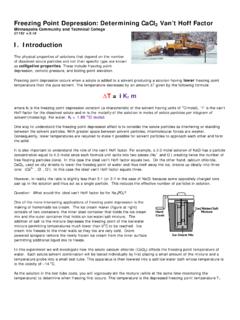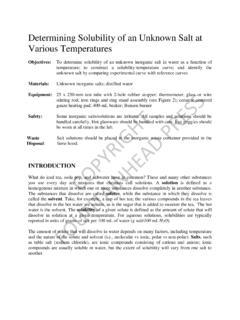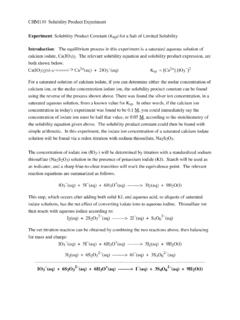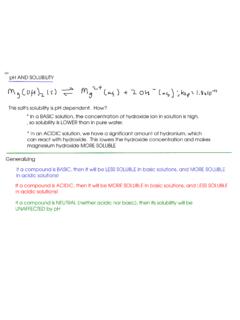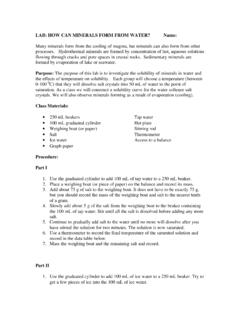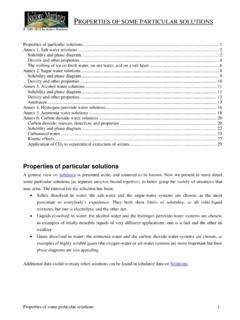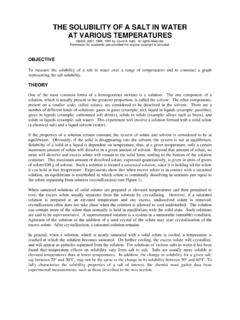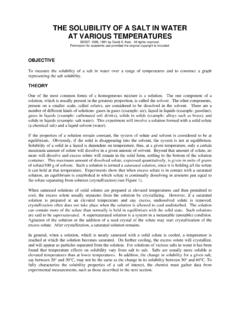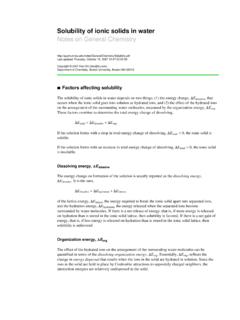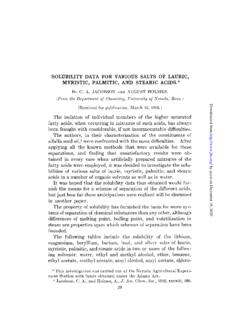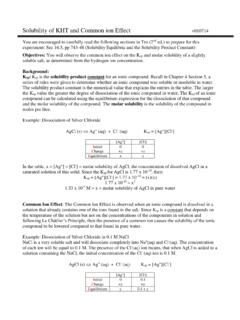Transcription of Solubility of Salt v.8.13 - Welcome to MCTCteach
1 Solubility of a salt Minneapolis Community and Technical College C1152 Solutions are homogeneous mixtures made up of one or more solutes dissolved in a solvent. The solvent is the component present in the greatest amount. Solutions are unsaturated when more solute will dissolve. Saturated solutions contain as much dissolved solute as is possible at that temperature. Supersaturated solutions have more solute dissolved than should be possible and are quite unstable. When disturbed, a supersaturated solution will precipitate out the excess solute leaving behind a saturated solution. Solubility is defined to be the maximum amount of solute that will dissolve in a given amount of solvent at a specific temperature. The Solubility of a salt is one of many physical properties that depend on temperature. The graph above illustrates how for many salts, Solubility increases at higher temperatures.
2 Typically, Solubility is recorded as grams of solute per 100g of solvent (Y Axis). For example, the Solubility of NaCl in water at 20 C is 36 grams per 100 g water. If you attempt to dissolve 40 grams of NaCl in 100 mL of water, 36 grams will dissolve to form a saturated solution and the remaining 4 grams will settle to the bottom of the container. However, all is not as it seems. The solid NaCl at the bottom of the container is continuously dissolving while at the same time ions from the solution are combining to reform the solid salt . This equilibrium process can be written as follows: NaCl(s) < ---- > NaCl(aq) The mass of the salt observed at the bottom of the beaker never changes because salt that dissolves is immediately replaced by salt that reforms the solid. For many solutes, increasing the temperature increases the Solubility of the solute and thus the graph of Solubility vs.
3 Temperature has an upward slope. In this experiment, you will determine the temperature dependence of potassium nitrate s Solubility in water. To do this you will prepare four different solutions, each containing a different amount of KNO3 dissolved in 5 mL of water. Each vial is then stirred and heated to dissolve all of the salt . After the solid completely dissolves, the stirred solution is allowed to slowly cool. At some point, the temperature will be low enough for the solution to become saturated. This point is identified by the formation of small solid crystals floating freely within the solution that resembles a snow flurry. The temperature when crystals are first observed is recorded for each trial solution. Knowing the temperature when crystals form and the masses of solute and solvent permits us to construct a Solubility graph (solubilityy vs.)
4 Temperaturex ) with Solubility in units of grams solute/100 grams solvent. After plotting the temperature and Solubility data, a linear and second order polynomial trend line analysis of the data is performed. The best fit for the data will then be used to determine the concentration of an unknown sample. II. MSDS: Chemical Information Potassium Nitrate KNO3 DANGER! STRONG OXIDIZER. CONTACT WITH OTHER MATERIAL MAY CAUSE FIRE. HARMFUL IF SWALLOWED, INHALED OR ABSORBED THROUGH SKIN. CAUSES IRRITATION TO SKIN, EYES AND RESPIRATORY TRACT. Health Rating: 1 - Slight Flammability Rating: 0 - None Reactivity Rating: 3 - Severe (Oxidizer) Contact Rating: 1 - Slight Lab Protective Equip: GOGGLES; LAB COAT Storage Color Code: Yellow (Reactive) Potential Health Effects Inhalation: Causes irritation to the respiratory tract. Symptoms may include coughing, shortness of breath.
5 Ingestion: Causes irritation to the gastrointestinal tract. Symptoms may include nausea, vomiting and diarrhea. May cause gastroenteritis and abdominal pains. Purging and diuresis can be expected. Rare cases of nitrates being converted to the more toxic nitrites have been reported, mostly with infants. Skin Contact: Causes irritation to skin. Symptoms include redness, itching, and pain. Eye Contact: Causes irritation, redness, and pain. Chronic Exposure: Under some circumstances methemoglobinemia occurs in individuals when the nitrate is converted by bacteria in the stomach to nitrite. Nausea, vomiting, dizziness, rapid heart beat, irregular breathing, convulsions, coma, and death can occur should this conversion take place. Chronic exposure to nitrites may cause anemia and adverse effects to kidney. Aggravation of Pre-existing Conditions: No information found.
6 III. Procedure You will be working in pairs as you do today s experiment. Construct the ring stand apparatus shown below. The vial and temperature probe should be securely clamped so that the entire apparatus can be moved as a whole. Two stir plates are required. Only one is equipped with a hot water bath (50 mL beaker) for heating purposes. The other hotplate is used only to stir the vial while it cools slowly. Move the ringstand apparatus as a unit between the two stir plates as needed. Obtain three vials and label each appropriately writing the vial number on the lid with a marker. Weigh each vial (cap on) and record the mass of each in your notebook. On a piece of creased weighing paper, measure out the amount of KNO3 given by the table below. Transfer the solid to the appropriate vial and reweigh to accurately determine the amount of solid.
7 Repeat this procedure for all three vials. Pipette mL of distilled water into each vial. Re-weigh each vial to determine the amount of water actually transferred to the vial. Vial # Approximate KNO3 mass (g) 1 ~6 g 2 ~4 g 3 ~2 g 1. Heat First (Hotplate) 2..then cool (Cold plate/ice) LoggerPro File: MCTC Solubility of a salt IMPORTANT: Keep wires away from the hot plate or they may melt and be damaged!!! Hotplate settings: Heat: 300oC Stir Setting: 900 RPM. Remove the cap from vial #1 and insert the magnetic stir bar. Use clamps to support the vial in the hot water bath (50 mL beaker). Note that the bottom of the vial must be centered on the stir plate and close (1-2 cm) to the bottom of the water bath for the magnetic stirrer to work. Continue heating the solution until the solid has dissolved.
8 Do not leave the vial in the water bath any longer than what is required to completely dissolve the solid. Why? When the KNO3 has completely dissolved, lift the entire ring stand apparatus and repositioning it over the cold stir plate. Continue stirring. Allow the vial to cool slowly. Crystals will suddenly form and build in intensity quickly over approximately 2 seconds. Record the temperature at the first sign of crystals. Reheat the vial/solution and repeat the cooling process (always stirring) a second time and average your two temperature results. Report the average value in your data table. Repeat this process for the remaining two vials and your unknown vial. Be sure to record your unknown s code number in your notebook before cleaning up. l Cleanup: Empty each vial in the appropriate "KNO3 student waste" container when finished.
9 Do not dispose of solutions down the drain. Place used vials in the dishwasher rack at the rear of the lab. Put away your equipment and wipe down your bench top area. Wipe down the balance areas. Experimental Suggestions: Do not let the water from the hot water bath spill over into your vial. Rinse and dry the temperature probe in between experiments to minimize solution cross contamination. Be sure the vial is centered over the stir plate for best stirring results. For the more concentrated solutions, it may be necessary to also stir with the temperature probe. Use a back and forth motion to break up the solid KNO3 at the bottom of the vial. A small piece of ice held at the bottom of the vial will accelerate the cooling process making it possible to determine an approximate saturation temperature. Once determined, you can go back and cool more slowly for two more accurate saturation temperatures.
10 Use the magnet picker to retrieve the stir bar from the waste solution container. IV. Data Analysis 1. Use Excel to construct a data table containing mass KNO3, mass H2O, T (oC), Solubility (gsalt/100 gsolvent) for all trials. Include an entry for the unknown solution's identification number, its characteristic temperature and Solubility determined from the trend line analysis. 2. Construct a Solubility graph using the temperature and Solubility information for the first three known trials. (Use the scatter plot option but do not connect the dots.) 3. Perform a linear and second order polynomial trend line analysis on the data. Display the equation and R squared value for each trend line on the graph. The equation that best fits the data will have a correlation coefficient closest to 1. 4. Use the best equation from step 3 to calculate the Solubility of your unknown solution.
